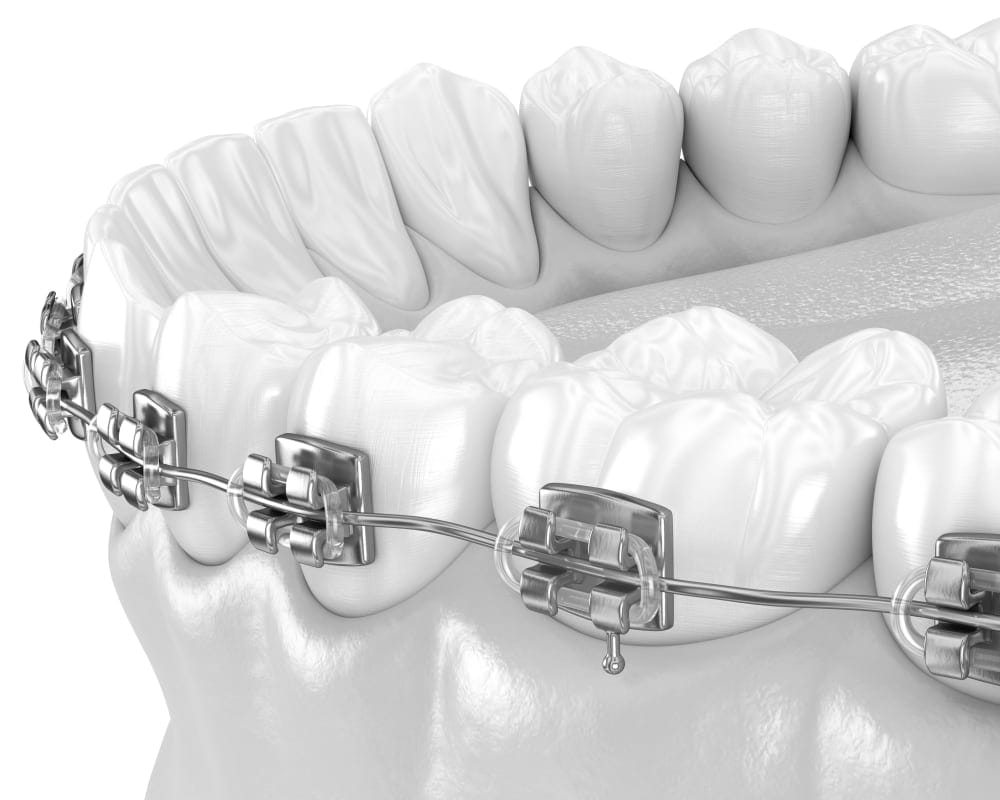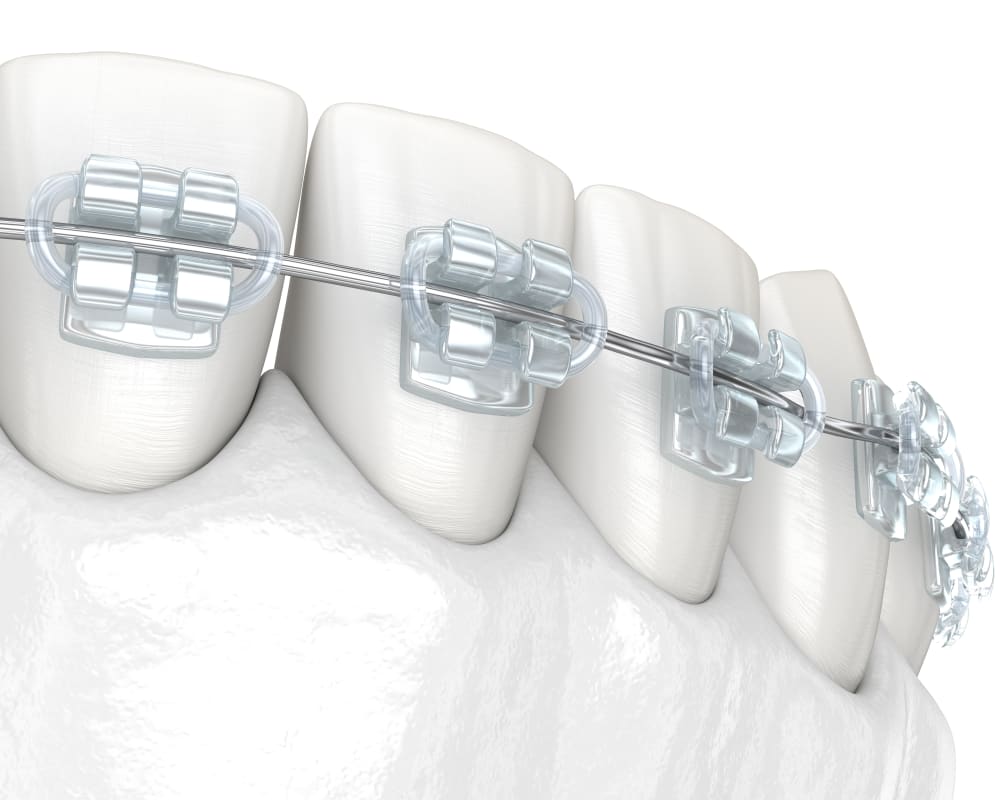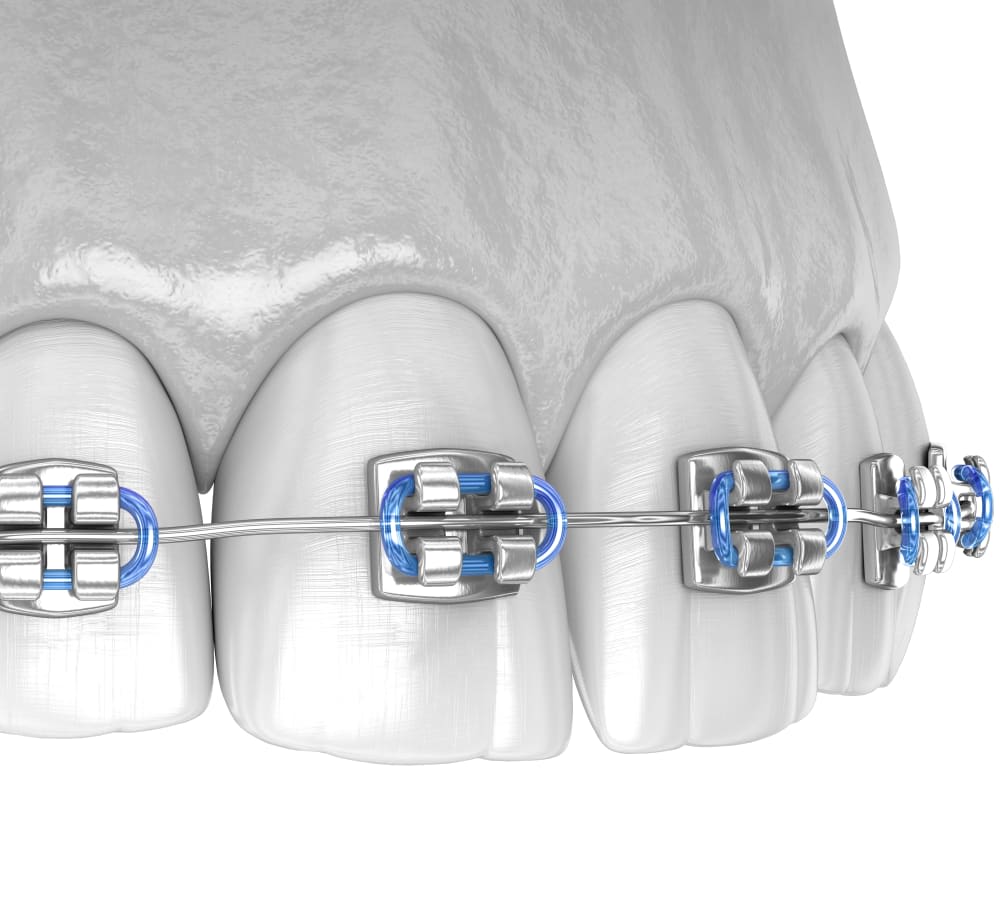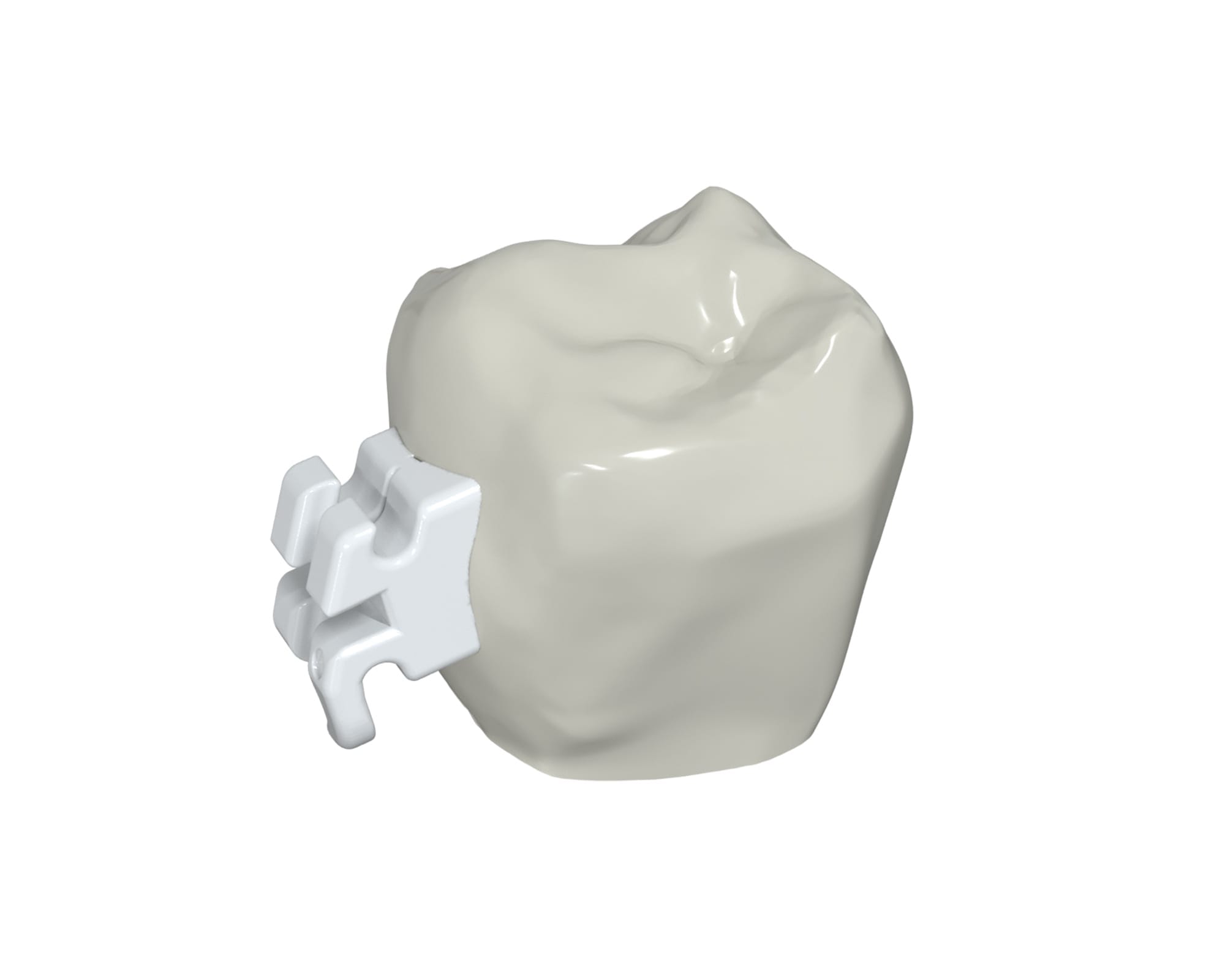Braces for a Healthier Bite
Conventional braces are a proven solution for straightening teeth and improving bite alignment. They have used them successfully for decades to achieve reliable, lasting results.
Braces are made up of three main parts: brackets, a flexible arch wire, and, for some patients, elastic bands.
The brackets are attached to the fronts of the teeth and hold the arch wire in place. The arch wire applies pressure to the teeth, moving them into their prescribed positions. Elastic bands are used when there needs to be additional force in specific directions.
Braces can be used to correct many different types of orthodontic issues, ranging from moderate to complex, for children, teens and adults of all ages.
Today, patients can choose from a variety of streamlined braces options that provide a cleaner, low-profile look for those with aesthetic concerns.

Flexible Payment Plans & Financing Options
Our orthodontists at Braced in BC believe that finances should never be a barrier to dental care. To help our patients manage the cost of orthodontic treatment, we offer flexible payment plans and convenient financing.
Types of Braces at Braced in BC
The type of braces we recommend for you will depend on several factors, including your specific orthodontic condition and your budget. We offer the following options.

Traditional Metal Braces
Metal braces are known for their efficacy, durability, and affordability. This is the type of braces that has been in use the longest. With traditional metal braces, metal brackets are secured to the teeth with a dental adhesive, with archwires threaded through them to guide teeth into their prescribed positions. Elastic ties or metal wires are used to hold the archwire in place.
The wires are usually made of metal alloys and have been optimized to deliver enough force to straighten the teeth while also be as comfortable as possible for the patient.
Translucent Braces
Although we refer to these braces as translucent, they only appear as though they are. This is because the brackets are made from a tooth-coloured ceramic that blends in with your teeth, creating the transparent effect and making them less visible than standard metal braces.
While translucent braces are a great option for many, they're not ideal for everyone. Ceramic is not as strong as metal, so some orthodontic conditions are better resolved with traditional metal braces.


Coloured Braces
Coloured braces are the ultimate in personalized orthodontic style! With coloured braces, the archwire is held firmly in place by tiny modules (elastic bands) that come in various colours.
These little elastics are replaced every four to six weeks as your braces are adjusted. This allows you to change the colour of your braces to match the season, your mood, your favourite sports team, or even the rainbow!
LightForce™ 3D Braces
At Braced in BC, we’re excited to offer LightForce™ 3D brackets as an orthodontic treatment option. These braces are 3D printed and custom-made to fit your teeth perfectly, ensuring an efficient, discreet, and comfortable treatment from start to finish.
The LightForce™ digital software allows your orthodontist to design a customized treatment to meet your needs. Based on your prescription, LightForce™ designs and 3D prints your braces, ready to be fitted at your orthodontist's office.

Living with Braces
Braces may take some time to get used to at first, but you'll quickly develop new routines around them. Here are several factors that will influence your day-to-day life during your braces treatment.
Adjustments
Adjustments are a crucial component of orthodontic treatment with braces. Approximately every four to eight weeks, you'll come to our office for your braces to be adjusted. This will ensure your teeth continue moving as expected with your treatment plan.
You may feel some discomfort in the hours or days after your adjustment appointments as your mouth adjusts. This discomfort is typically short-lived and best managed with over-the-counter painkillers.
Elastics
Elastics, also called rubber bands, are used with traditional braces to apply additional force to certain areas of your mouth to guide tooth movement. They are a key part of your treatment.
These elastics do not keep their strength for long, though, and should be changed out at least twice a day. Many of our patients find that making it a habit to change their elastics after each meal makes it easier to remember.
Always follow your orthodontist's instructions regarding your elastics. Please contact our office if you notice that your elastics frequently break, or if the hook for your elastics comes off.
Hygiene
Good oral hygiene is more important than ever when you have braces. Braces create all sorts of small spaces and crevices where plaque can build up, leading to tooth discolouration, tooth decay, and gum disease.
To keep your teeth and gums in good health during your braces treatment, be sure to brush after every meal with a soft toothbrush and fluoride toothpaste. A Proxabrush® is a toothbrush specifically designed to clean the spaces between braces. You can also use a Waterpik™ or an air flosser to help flush out stubborn food particles.
Flossing regularly is important and simpler than you might think. Simply thread the floss through the gap between the archwire and your teeth. Gently pull the end back toward the tooth and move the floss up and down between your teeth.
Eating
Undergoing orthodontic treatment with braces, unfortunately, requires some limitations on your diet.
You should avoid chewy or sticky foods (like caramel or licorice), hard or crunchy foods (hard candies, nuts, or whole raw vegetables), and foods you have to bite into (like corn on the cob or apples). It's also a good idea to avoid sugary drinks as well.
Cutting food into small pieces and chewing slowly and carefully will allow you to enjoy a greater variety during your treatment, but always follow your orthodontist's recommendations.
Mouth Guards
If you're an athlete, there's no reason for braces to prevent you from playing the sports you love. But if you want to continue getting out on the field, court, or rink during your treatment, we recommend wearing a sports mouth guard to protect your teeth, mouth, and braces from damage.
Retainers
After your active orthodontic treatment with braces (or Clear Aligners) is complete, you'll need to wear a retainer to keep your teeth in their new, straightened positions while the jaw bone around their roots reforms and hardens.
You will likely start by wearing your retainer for at least 24 hours a day, every day, for the first eight weeks or so after getting your braces. After this point, and with your orthodontist's approval, you may begin to wear it only at night.
Questions About Braces? We've Got Answers.
If you're considering orthodontic treatment with braces, you probably have some questions. Begin by reading our braces FAQs to learn more about how they work, and their advantages.
-
How much do orthodontic braces cost?
The cost of orthodontic treatment can vary significantly depending on the nature and severity of the misalignment being addressed and the type of braces being used. Your orthodontist will provide you with an estimate for the cost of your treatment at the beginning.
If you already have an estimate from your orthodontist, you can use our cost calculator to determine your approximate monthly payments.
-
Who is a candidate for braces?
Most children, teens and adults who have healthy teeth and gums are generally considered good candidates for braces. Certain people with significant recession or oral health conditions may not be candidates.
Braces are available in various styles and can effectively address a wide range of moderate to complex orthodontic issues, meaning there are very few limits on who can benefit from them.
-
What are my options for low-profile braces?
For a discreet appearance, we offer LightForce™ 3D Braces and translucent braces at Braced in BC.
LightForce™ 3D Braces are custom-made to fit your teeth perfectly, which means an efficient, discreet, and comfortable treatment.
Translucent braces have ceramic brackets that match the colour of your teeth, allowing them to blend in with your smile. You can learn more about these braces on this page under 'Types of Braces' above.
Clear aligners are also an option for those looking for a low-profile orthodontic treatment.
-
How long will I need to wear braces?
The average treatment time for braces ranges from 12 to 24 months, but this can vary significantly among patients. The duration of your orthodontic treatment depends primarily on the type and severity of your misalignment. As you might expect, mild or moderate cases are quicker to treat than more complex ones.
-
How long until I get used to my braces?
You'll probably need a week or two to become fully accustomed to your braces after getting them. You may find it hard to resist poking them with your tongue as you get used to how the wires and brackets feel.
You may also notice that certain areas of your mouth rub against the braces and get sore. Orthodontic wax can be placed on the braces in these areas to help create a smoother surface with less friction as your mouth adjusts. This discomfort is only temporary, and your mouth will probably feel normal again within a couple of weeks.
-
Can I change the colour of my braces?
If you have metal braces with rubber bands, you can update the colour of the bands when you come in for an adjustment appointment. Orthodontic elastics can come in a rainbow of different colours. Having the option to personalize your braces in this way can make the orthodontic treatment process a little more fun!
We also often use e-chains to close the spaces between teeth. These chains are available in a variety of colours to suit your preference.
You can change the colour of your braces based on the season, upcoming holidays, or your personal style.
-
Do braces hurt?
You will almost certainly experience some discomfort at different points of your orthodontic treatment with braces. However, any pain you feel during your braces treatment is temporary and usually resolves over a few days or even hours.
Discomfort from braces typically lasts a week after first getting them and for a few hours or days after adjustments, as teeth shift. Patients often describe it as pressure or an ache, which can usually be managed with over-the-counter painkillers.
Temporary discomfort from braces may occur when brackets rub against the inside of your mouth, especially when first applied or after adjustments.
Applying orthodontic wax to areas that cause rubbing helps smooth the surfaces. Painkillers can be used to manage any discomfort until it subsides.
-
Can adults get braces?
Yes, adults can get braces! Many adults today choose to pursue orthodontic treatment they missed out on during their youth, aiming to enhance both their oral health and the appearance of their smiles.
Many of our adult patients prefer the lower profile, more streamlined look of translucent ceramic braces, self-ligating braces, or clear aligners. All these options allow you to straighten your teeth without the more pronounced appearance of traditional braces.
-
Can kids get braces?
Yes, children as young as seven years old may be candidates for braces in some cases. Certain developing misalignments and bite problems can be more easily treated when children are young. We can work with and guide their oral development rather than undoing issues already established later on.
At our clinic, we take a very conservative approach to braces for children and only prescribe them when there's a serious risk of future orthodontic problems.
-
Do I have to brush more with braces?
Throughout treatment with braces, you should be sure to brush your teeth after each meal.
Oral hygiene becomes more important than ever while you're wearing braces. The presence of braces in your mouth introduces a multitude of tiny crevices, nooks, and crannies that were not there before. It's very easy for food particles to get caught in these tiny spaces, making them a breeding ground for bacteria.
To avoid developing cavities (not to mention tooth discolouration and bad breath), extra vigilance with your oral hygiene is essential.
-
How do I floss with braces?
Flossing with braces may seem complicated, but it's fairly straightforward once you get the hang of it!
To floss with braces, insert the floss through the space between the archwire and your teeth. You can try floss threaders to make this easier. Gently pull the floss toward the back of the tooth and move it up and down between the teeth. Repeat this for each pair of teeth.
-
What can I eat while I'm wearing braces?
Eating with braces requires some extra care, but you should still be able to eat many of the foods you love.
Avoid hard, crunchy, or sticky foods. Chew carefully with braces and take your time. Don't bite into foods like apples or corn on the cob (cut apples into pieces and shell corn instead!) and avoid chewing gum.
You can generally continue eating your normal diet, with a few modifications.
-
Can I still play contact sports if I wear braces?
Even when not undergoing orthodontic treatment, we would recommend avoiding sports that may result in direct blows to the mouth.
Other contact sports, like football or rugby, may be possible if you wear a mouth guard, but we advise extreme caution in these cases as well.
For most sports, though, you should be able to keep playing with no problem. If you want to continue getting out on the field, court or rink during your treatment, we recommend wearing a sports mouth guard to protect your teeth, your mouth, and the braces themselves from damage.
